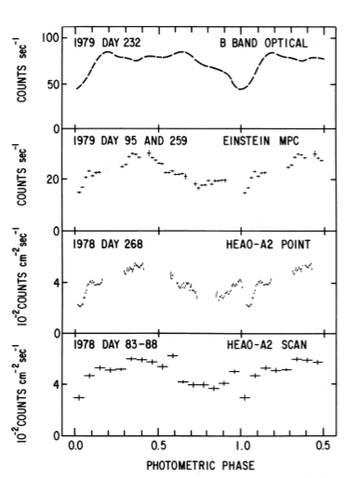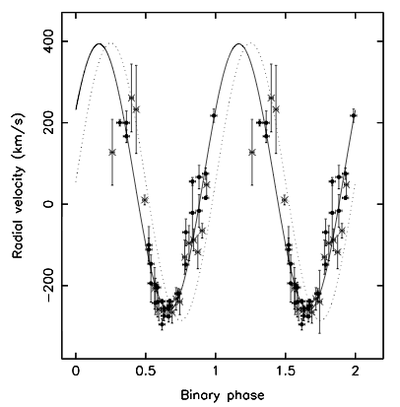3A 1822-371
!!!!!!!!!!!!!!!!!!!!!!!!!!!!!!!!!!!!!!!!!!!!!!!!!!!!!!!!!!!!!!!!!!!!!!!!!!
Based on Burderi et al., 2010, Jonker at al. 2003 and White et al. 1981
!!!!!!!!!!!!!!!!!!!!!!!!!!!!!!!!!!!!!!!!!!!!!!!!!!!!!!!!!!!!!!!!!!!!!!!!!!!
System Overview
| Parameter | Value | Unit |
|---|---|---|
| Distance | 2-3 | kpc |
| Pspin | 0.59 | s |
| Neutron star mass | >0.97 | M⊙ |
| Companion star mass | 0.33 | M⊙ |
| Inclination | ~85 | deg |
| Lx | 4.4x1034 | erg s-1 |
| a sin i | 1.006(5) | lt s |
Observational Properties
3A 1822-371 is a very well known eclipsing and dipping low mass X-ray binary (LMXB). This source is seen almost edge-on (inclination around 85 deg.) and its X-ray light curve shows a 5.57 h modulation (Hellier & Mason 1989). This shows clear signs of orbital modulation in both the X–ray and optical bands (White et al. 1981; Seitzer et al. 1979; Mason et al. 1980), with a period of 5.57 hours.
Adopting a distance of 2.5 kpc The observed average unabsorbed flux of the source in the 0.1 − 100 keV energy range is ∼ 1.5 × 10^(−9) ergs cm^(−2) s^(−1) (Ilaria et al. 2001), which gives a luminosity of ∼1.2 × 10^36 ergs s^(−1). A particular characteristics of this source is the ratio of X- ray over optical luminosity. This is about 20 (Parmar et al. 2000), while the average value for LMXBs is about 500 (van Paradijs & McClintock 1994). This apparent low luminosity of 3A 1822-371 has to be associated to the high inclination of the system with respect to the line of sight. White et al. (1981) showed that the X–rays are emitted from an extended source, a so called Accretion Disk Corona (ADC) which is periodically partially eclipsed by the companion star (at orbital phase 0.0) as well as partially obscured by structure in the accretion disk whose height varies but is greatest at phase 0.8 and least at phase 0.2 (White et al. 1981). The short orbital period makes 3A 1822–371 a compact LMXB.
Interesting is the study of White et al. 1981 in which data of different observations are folded about the X-ray period and the photometric B band light curve is shown. On these observations they noticed that:
- The X-ray light curve is composed of two different features:
- a smooth modulation with a broad minimum and an additional sharp minimum;
- The dip occurs at 0.04 in phase after the optical minimum (phase zero at 2444105.668 JD);
- The light curve has remained constant over 2 yr;
- The amplitude of optical and X-ray modulations are similar.
Figure taken from White et al. 1981
3A 1822-371 can be considered as the prototypical Accretion Disc Corona (ADC) source. Indeed, the light curve of 2A 1822–371 shows both dips and eclipses of the X-ray source by the companion star. The partial nature of the eclipse indicates that the X-ray emitting region is extended and that the observed X-rays are scattered in an accretion disk corona (ADC, White et al. 1981). The X-ray light curve shows clear signs of orbital modulation with a binary orbital period of 5.57 h. This X- ray modulation is probably caused by the obscuration of the ADC by the thick rim of an accretion disk.
The orbital period of the source increases gradually (Hellier et al. 1990). Jonker & van der Klis (2001) reported on the discovery of 0.59 s X-ray pulsations in this source in an RXTE ob- servation performed in 1998. The timing analysis of the pulse arrival times indicates a circular orbit with an ec- centricity e < 0.03 (95% c.l.) and an a sin i for the neutron star of 1.006(5) lt-s.
The comparison between the pulse period measured in 1996 and in 1998 based on data of RXTE indicates that the neutron star is spinning up. Jonker et al. (2003) suggested, studying the spectroscopic measurements of the radial velocity curve of the companion, a lower limit to the mass of the neutron star and to that of the companion star of 0.97±0.24 and 0.33 ± 0.05 M⊙, respectively.
Figure taken from Jonker et al. 2003

